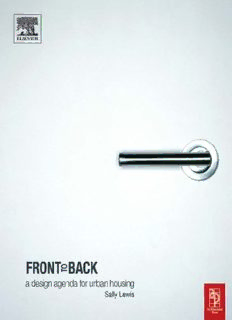
Front to Back: A design agenda for urban housing PDF
Preview Front to Back: A design agenda for urban housing
Prelims.qxd 29*10*04 16:21 Page i Prelims.qxd 29*10*04 16:21 Page ii for Brian To offset some of the horrible carbon produced in the making of this book, we’ve planted 316 healthy young trees in Whitmore Forest,England. Prelims.qxd 29*10*04 16:21 Page iii AMSTERDAM (cid:127) BOSTON (cid:127) HEIDELBERG (cid:127) LONDON (cid:127) NEW YORK (cid:127) OXFORD PARIS (cid:127) SAN DIEGO (cid:127) SAN FRANCISCO (cid:127) SINGAPORE (cid:127) SYDNEY (cid:127) TOKYO Architectural Press is an imprint of Elsevier Prelims.qxd 29*10*04 16:21 Page iv Architectural Press An imprint of Elsevier Linacre House,Jordan Hill,Oxford OX2 8DP 30 Corporate Drive,Burlington,MA 01803 First published 2005 Copyright © 2005,Sally Lewis.All rights reserved The right of Sally Lewis to be identified as the author of this work has been asserted in accordance with the Copyright,Design and Patents Act 1988 No part of this publication may be reproduced in any material form (including photocopying or storing in any medium by electronic means and whether or not transiently or incidentally to some other use of this publication) without the written permission of the copyright holder except in accordance with the provisions of the Copyright,Designs and Patents Act 1988 or under the terms of a licence issued by the Copyright Licensing Agency Ltd,90 Tottenham Court Road,London,England W1T 4LP. Applications for the copyright holder’s written permission to reproduce any part of this publication should be addressed to the publisher British Library Cataloguing in Publication Data A catalogue record for this book is available from the British Library ISBN 0 7506 5179 2 For information on all Architectural Press publications visit our website at http://books.elsevier.com/architecturalpress Typeset by Charon Tec.Pvt.Ltd,Chennai,India Printed and bound in Italy Cover photography by Penny Cottee Prelims.qxd 29*10*04 16:21 Page v Contents Foreword vii Richard Rogers,Richard Rogers Partnership Preface ix Jon Rouse,Chief Executive,The Housing Corporation Acknowledgements x Introduction xiii Part one Chapter 1: The urban design agenda 3 Martin Crookston,Llewelyn Davies Chapter 2: The sustainability agenda 13 Randall Thomas,Max Fordham LLP Chapter 3: The community agenda 27 Patrick Hammill,Levitt Bernstein Chapter 4: The social agenda 38 Part two Chapter 5: A design agenda 46 Chapter 6: Introduction to the case studies 72 Chapter 7: Housing at Parc de Bercy,Paris 74 Chapter 8: Tango Housing at Bo01,Malmo 90 Chapter 9: Century Court,Cheltenham 110 Prelims.qxd 29*10*04 16:21 Page vi Contents Chapter 10: Palm Housing,Coin Street,London 128 Chapter 11: Homes in the Calle del Carme,Barcelona 146 Conclusion 160 References and further reading 166 Illustrations acknowledgements 168 Index 171 vi Prelims.qxd 29*10*04 16:21 Page vii Foreword Housing is a basic human need and good design is an essential part of housing.One of the key messages in this excellent book is that although beautiful buildings enrich our lives, they do not exist in isolation. Key to successful urban planning is the space between buildings – delivering high calibre,well-designed public space – is the most important challenge facing our cities today. Design is about giving order,scale and beauty to the buildings and the space between them.The book celebrates some excellent examples of good sustainable development that meet contemporary needs – in Barcelona or Amsterdam for instance.Sally’s book brings together some of the best urban housing to be found in Britain and abroad – an impressive collection of work that sets a benchmark for urban housing designers worldwide. Richard Rogers Richard Rogers Partnership This page intentionally left blank Prelims.qxd 29*10*04 16:21 Page ix Preface What makes a great residential neighbourhood? I happen to live in one;tight,late Victorian, grid,generously proportioned terraced houses with a scattering of ground floor retail uses and a network of local parks.The key routes converge on a small neighbourhood centre before giving way to a succession of larger apartment blocks,making good use of the wonderful views from the hillside leading up to Wimbledon Common.At the heart of the neighbourhood are some very sound design principles.A Victorian area works because the tight continuous frontages give a strong sense of community and communal living.The apartment block areas get away with a less formal urban structure because of the quality of spaces in-between and the proliferation of trees and other greenery.On the hillside,a number of now pre-eminent architects cut their teeth,including Sir Terry Farrell.Although their designs were certainly innovative in their day,they also abided by the principles of good urban design. The case studies presented in this book are all unique but all share the same essential ingredients for success, excellence in spatial planning, prioritisation of public spaces, selfless architecture and attention to detail. Each of these neighbourhoods was designed to last,built on true sustainable principles,combined economic,social and environmental values. Each of the neighbourhoods also flowed from a clear set of community values that respected the context without slavishly imitating the past. The sad fact is that,at present,there are very few examples,in the UK at least,of great contemporary housing,particularly on a significant scale.The Building for Life standard, which seeks to capture great development, has so far only identified some 20–25 schemes that hit the mark on the key indicators of good urban design,good architecture and good public spaces.If the ingredients are clear,one wonders whether the recipe is too difficult to follow,but then that cannot be the case.If the Georgians could do it,and the Victorians could do it,and the Garden City movement could do it,then there is no reason why we cannot achieve the same success at the start of the 21st century.It simply needs the application of client commitment,the involvement of a skilled design team,a realistic budget and good project management. I hope that the material contained in this book will inspire housing providers to no longer settle for a lowest common denominator solution, but to achieve places of lasting worth. Jon Rouse Chief Executive,The Housing Corporation
Description: